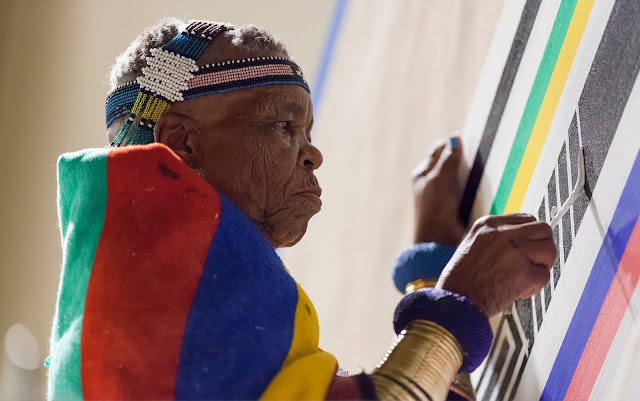Esther Mahlangu born in 1935 Middelburg is Ndebele artist from Mpumalanga, South Africa and belongs to the South Ndebele people.She is known for her bold large-scale contemporary paintings that reference her Ndebele heritage.
Mahlangu began painting at ten years old, following the teachings of her mother and grandmother. A tradition of her native South Ndebele people is for females to paint the exterior of houses. It is in this cultural tradition where Mahlangu began her artistic journey. Mahlangu art references patterns found in clothing and jewelry of the Ndebele people. The colors and patterns she uses are typically very colorful and geometric. Her paintings are large in scale.
Southern Ndebele
The South African Ndebele are one of the Nguni tribes. The Nguni tribes represent nearly two thirds of South Africa's African population and can be divided into four distinct groups; the Central Nguni (the Zulu-speaking peoples), the Southern Nguni (the Xhosa-speaking peoples), the Swazi people from Swaziland and adjacent areas and the Ndebele people of the Mpumalanga Gauteng and Limpopo.
The two Ndebele groups are separated not only geographically but also by differences in their languages and cultures. The Ndebele of the Northern Province consist mainly of the BagaLanga and the BagaSeleka tribes who, by and large, adopted the language and culture of their Sotho neighbours. The North Ndebele people resided an area stretching from the town of Warmbaths in the south, to the Limpopo River in the north and from the Botswana border in the west to the Mozambique border in the east. However, they were mainly concentrated in the districts of Pietersburg, Bakenberg and Potgietersrus. Mpumalanga, much of which consists of the area known as the Lowveld, stretches from the town of Piet Retief in the south to Lydenburg / Pilgrim's Rest in the north and from the towns of eMalahleni and Groblersdal in the west to the Mozambique border in the east. The Springbok Flats separated the North Ndebele and those in the east from one another. more
Mahlangu first gained international attention in 1989 at a European artist exposition titled Magiciens de la terre (Magicians of the World). Later in 1991, Mahlangu was commissioned by BMW to create an art car, as other BMW Art Car creators had done before (including Andy Warhol, David Hockney and Frank Stella). The car, a BMW 525i, was the first "African Art Car" which was painted with typical motifs of the Ndebele tribe. She was the first non-Western person and female to design one of these art cars. The car was later exhibited at the National Museum of Women in the Arts in Washington, DC in 1994.
Her designs were also reproduced in 1997 on the tails of British Airways planes and more recently the same technique was used by the artist to paint on the new Fiat 500 on the occasion of the exhibition "Why Africa?" (2007, Turin). Mahlangu is one of the few African artists whose art is often exhibited on the international scene. Her works are in major private collections including that of The Contemporary African Art Collection (CAAC) of Jean Pigozzi and in many Western museums. Despite being an internationally recognized artist, Esther Mahalangu lives in her village in close contact with her culture.
-------------------------
South African Ndebele artist Esther Mahlangu discusses the early years
of her paining practice, her designs and pigments, and the preservation
of culture in this talk at VMFA. The conversation includes Esther
Mahlangu, Marriam Mahlangu, Grace Masango, and Richard Woodward Curator
of African Art.
Themes
The artist follows a local tradition that states that this particular type of painting technique is handed down in the family, communicated, learned and transmitted only by women. These paintings are closely connected with the ancient tradition of decorating the houses on the occasion of the rite of passage for boys. Between eighteen and twenty years of age, the youth of the tribe went to "a school of circumcision", the ritual which confirmed their passage to adulthood.
The art of Esther Mahlangu highlights the tension between local and global, between the anchor and detachment. Despite continuing to use the same "artistic vocabulary" closely tied to the traditions of her race, Mahlangu has dramatically changed the media and techniques with which they work. The artist, in addition to using industrial pigments and colors, decorates using lines and geometric paintings for sculptures, ceramics, automobiles (Mainly BMW's) and even airplanes.
Present Day
As an artist in residency, Esther Mahlangu was commissioned in 2014 by the Virginia Museum of Fine Arts to create two large works of art.
Mahlangu directs a school which teaches young girls not only painting but also the technique of painting designs on particular compositions of beads. The tradition is not a static entity. As the work of the same Mahlangu suggests, "tradition" is a mobile field, future-oriented and ready to incorporate diverse stimuli.
In fact, although South Africa is now one of the African States which is able to facilitate and promote the work of their artists both nationally and internationally with the likes of the biennial event in Johannesburg, the work of Esther Mahlangu is even more courageous because she was born and grew up in political and social turmoil.
Via: wikipedia
edited by Dumbanenguebyceleste : Celeste / April 2016








No comments:
Post a Comment